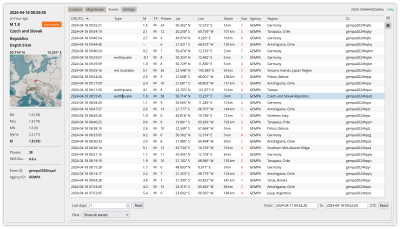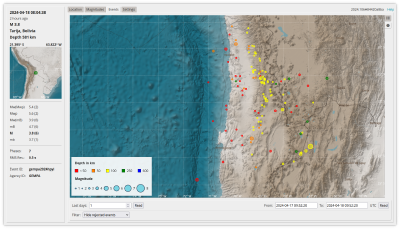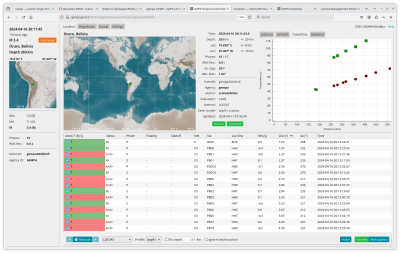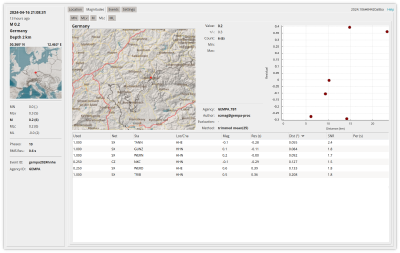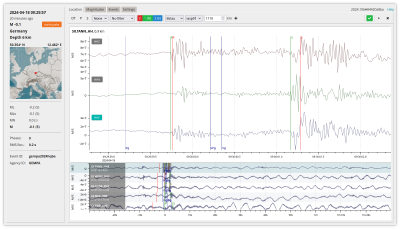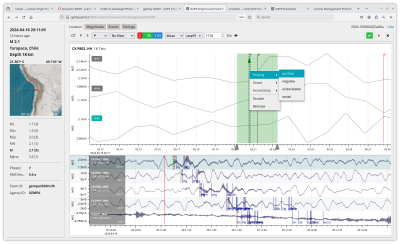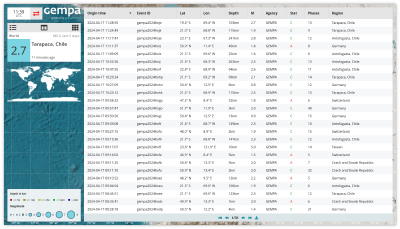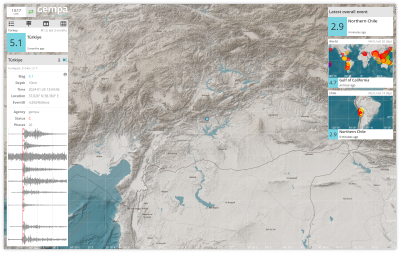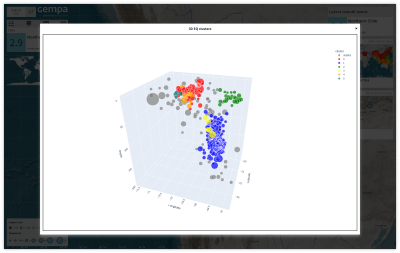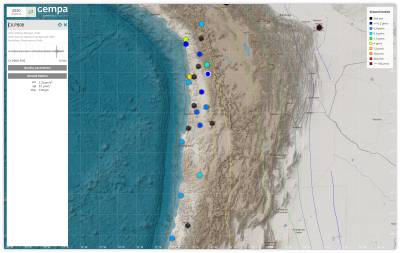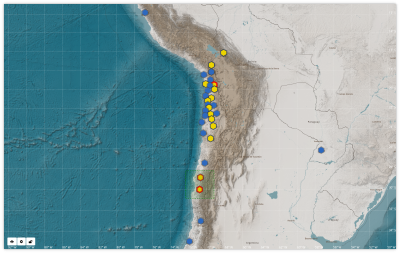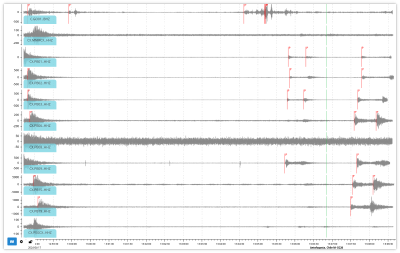GAPS with updated OriginLocatorView for processing earthquakes in web browsers
Apr 17, 2024
Categories:
Products
The ability to access and interact with a SeisComP system
through a web interface adds great flexibility when working with Earthquakes,
explosions or other seismic sources. You may present results from your system
and update or create new ones while being remote on meetings, in the field or in
home office.
GAPS / WebApps is our offer for web-based work replacing the graphical
modules scolv, scrttv, scmv and scesv well-known from OpenSource
SeisComP. We have now modernized GAPS / WebApps
and provide the new version through a software update accommodating new
features and allowing us to further strengthen the built-in OriginLocatorView.
Before reading further or even updating GAPS / WebApps in your system
you may take a moment and try out
the latest version on our demo system
. For
relocating events in the OriginLocatorView you will be requested to enter a user
name and password. Using guest1 for both will give you guest access but
committing will be not permitted.
Functional improvements and new look
GAPS provides multiple components such as the OriginLocatorView, EQView, StationView and TraceView for not only replacing the well-established scolv, scesv, scmv and scrttv modules known from SeisComP but also to provide features of particular interest when analysing data through the web. We have modernized all these components resulting in a fresher look and feel and more features. Especially for the OriginLocatorView we have added valuable options and we are expecting to provide even more in the near future. These changes were triggered by a large request from many user who appreciate the option to work on their system from anywhere and to easily reach out to the public with their information on seismicity.
OriginLocatorView
Our OriginLocatorView supports the detailed analysis of events in your SeisComP system. Its design is adopted from scolv with similar functionality and works flow allowing operators to easily work both worlds.
Just like in scolv, event catalogs can be loaded and individual events can be selected from a table and even a map. The currently loaded event is always shown in the summery view on the left hand side. With the new version this summary also shows more details such as magnitudes and event type if set.
The preferred origin of the selected event is loaded to and shown in the Location tab. As known from scolv you may select phase detections (arrivals), relocate the event, choose the most appropriate locator and its profile for relocating and, when ready, eventually commit your solution to the SeisComP system where it is automatically integrated. Committing with additional options further allows you to set the event type, the preferred magnitude or the status of the most recent solution (origin). You may also open the phase picker window for waveform analysis and manual pick review and phase detection.
The brand-new Magnitudes tab shows you the related magnitudes. Here we are expecting to add more features soon including manual amplitude measurements and interactive computation of magnitudes.
For reviewing or adding phase picks, the picker window can be opened by clicking on the picker button in the Location tab. It is conveniently integrated into GAPS showing event information side-by-side with your waveforms on which you may pick phase onsets. The data may be filtered to improve visibility of the relevant signals. While picking phase onsets you may also add valuable attributes to picks such as polarity information or onset uncertainty.
With the new version the browsing and zooming of waveforms as well as phase picking has become even more similar to SeisComP’s scolv:
- Zooming in time by right mouse-button actions instead of mouse wheel.
- Adding phase polarities, onset type and time uncertainties to phase picks using right mouse-button actions. This new procedure was previously not supported at all.
EQView and StationView
EQView and StationView essentially show located events and the monitoring network on a map or in a table. Widgets and tables can be formed in EQView to focus on specific areas, magnitude ranges and time periods. In EQView events may be selected and parsed to custom scripts which in turn may create interactive plots and diagrams like the shown 3D cluster cube that can be rotated to learn about the 3D geometry of the seismicity.
TraceView
The TraceView allows you to view waveforms in real time along with phase picks and event informtion. The stations are interactively selected on a map where they can be shown as single symbols for individual stations or by a dynamic cluster symbol for dense networks.
When the data are shown, phase detections are visible and the time of the latest event is indicated by the green line on the data. The magnitude and the region of the event are printed below the time axis. Data can be interactively filtered for improving signal visibility.
Continuous developments
With the new version of the GAPS frontends we have a modern base for all our future developments allowing us to continuously add new features to all components. Already now we have added the new Magnitudes tab for viewing computed network and station magnitudes. We are committed to also make these important observations interactively accessible allowing you to steer the measurement of amplitudes and the computation of station and network magnitudes in the OriginLocatorView.
Try out and get excited
You may try out GAPS with all components through our demo website . If you wish to relocate in the OriginLocatorView you will be requested to provide a user name and a password which are: guest1 and guest1, respectively, but committing is still not allowed for this user. Also check out our GAPS product information and read our the technical documentation of GAPS online.
Installation and configuration
The GAPS modules are provided by us as one package for the server, gaps-server, and one package for the web frontends either with the OriginLocatorView, gaps-frontends2-all or without the OriginLocatorView, gaps-frontends2. You may choose from either of the frontends depending on your license subscription. Before our modernization of GAPS the frontends were installed as gaps-frontends and gaps-frontends-all.
For the actual installation of the new GAPS version we recommend our publicly available gsm module . After installation of gsm in ~/install/gsm you will first setup gsm:
cd ~/install/gsm
./gsm setup
and then run gsm to install or update the packages including the OriginLocatorView:
cd ~/install/gsm
./gsm update
./gsm remove gaps-frontends-all gaps-frontends gaps-frontends2
./gsm install seiscomp gaps-server gaps-frontends2-all
or the frontends without the OriginLocatorView:
cd ~/install/gsm
./gsm update
./gsm remove gaps-frontends
./gsm install seiscomp gaps-server gaps-frontends2
Removing the packages gaps-frontends-all and gaps-frontends will delete the directory $SEISCOMP_ROOT/share/gaps/apps/ unless you have any custom content therein.
Our development of gaps-frontends2-all has followed that of gaps-frontends2 with some delay. Already before publishing gaps-frontends2-all you could benefit from gaps-frontends2 by a mixed installation of gaps-frontends2 and gaps-frontends-all. This mixed installation, however, required a rather complicated setup which is now, with provision of gaps-frontends2-all much easier and you may even run the legacy version in parallel with the new one. All that needs to done after the installation of the gaps-frontends2-all or gaps-frontends2 is to correctly configure the parameter mediaDirectory in the configuration file of GAPS, gaps.cfg, for pointing to the new version (2), e.g.:
mediaDirectory = @DATADIR@/gaps/2/apps
Deprecation information
As we have now fully switched to gaps-frontends2 and gaps-frontends2-all the legacy packages gaps-frontends and gaps-frontends-all have been deprecated and will no longer receive any updates.
